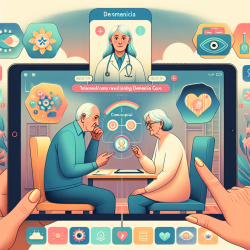The Future of Dementia Care: Telemedicine Takes the Lead
In the wake of the COVID-19 pandemic, the demand for telemedicine has surged, offering a lifeline for patients who require medical attention without the risk of exposure to the virus. Telemedicine has proven to be particularly beneficial in fields like neurology, where it has been employed to support the diagnosis and treatment of adult-onset dementia disorders, including Alzheimer's disease (AD).
Telemedicine vs. Traditional Face-to-Face Assessments
A recent systematic literature review investigated whether neuropsychological tests traditionally used in face-to-face (FTF) contexts could be reliably administered via telemedicine. The findings are promising: the Mini-Mental State Examination (MMSE), a primary screening tool for dementia, shows negligible differences in results whether administered traditionally or through videoconferencing.
Other tests, such as the Token Test, Comprehension of Words and Phrases (ACWP), and the Controlled Oral Word Association Test, also demonstrated high reliability across both modalities. These findings are crucial as they suggest that telemedicine can effectively bridge the gap in dementia care, especially in remote areas where access to specialists is limited.
Why Telemedicine is a Game Changer
Telemedicine offers numerous advantages:
- Improved Access: Patients in rural or hard-to-reach areas can receive care without the need for travel.
- Reduced Costs: By eliminating travel expenses and reducing the need for physical infrastructure, telemedicine can lower healthcare costs.
- Increased Convenience: Patients and caregivers can access healthcare services from the comfort of their homes.
- Enhanced Monitoring: Regular and consistent monitoring is possible, which is critical for managing chronic conditions like dementia.
Furthermore, telemedicine can facilitate the gathering of a large number of patients in a short period, helping to reduce waiting lists and improve assessment times. This is particularly beneficial for older adults who may face difficulties in traveling due to health issues or lack of transportation.
Challenges and Considerations
While telemedicine holds great promise, there are challenges that need to be addressed:
- Technical Issues: Reliable internet connectivity and access to necessary devices are essential for successful telemedicine sessions.
- Regulatory Hurdles: Licensing and authentication processes can be time-consuming and add to administrative burdens.
- Training: Healthcare providers need adequate training in the technical, legal, and clinical aspects of telemedicine.
Moreover, certain scoring procedures in telemedicine may require standardization to ensure their reliability. Despite these challenges, patient acceptance of telemedicine is generally high, with many appreciating the convenience and privacy it offers.
The Road Ahead
Telemedicine is not just a temporary solution; it is poised to become a cornerstone of modern healthcare. By making dementia care more accessible and affordable, telemedicine can significantly enhance the quality of life for patients and their families. As we continue to refine these technologies and address existing challenges, the potential for telemedicine in dementia care is boundless.
For more information, please follow this link.










